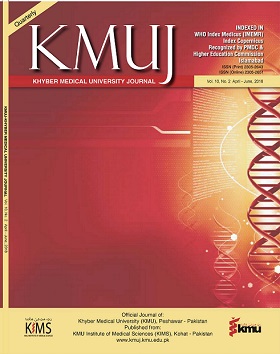COMPARISON OF SUSTAINED PRESSURE VS ISCHEMIC COMPRESSION ON TRIGGER POINTS IN CHRONIC MYOFACIAL PAIN MANAGEMENT
Main Article Content
Abstract
ABSTRACT
OBJECTIVE: To determine the effect of different trigger points approaches in improving chronic myofascial pain.
METHODS: This randomized controlled trial was conducted in Railway General Hospital, Rawalpindi, Pakistan from July-December 2016. Patients were randomly divided into two treatment groups through lottery method, in which 37 male participants who full filled the inclusion criteria (persistent pain >6 months, gradual onset of pain and impaired level of activity) were randomly allocated to sustained pressure (Group A) and ischemic compression (Group B) treated groups. Both groups received eight treatments sessions. They were evaluated at baseline and after 8th visit through Numeric Pain Rating Scale (NPRS) and Chronic Pain Acceptance Questionnaire (CPAQ).
RESULTS: Within the group-A the pre and post-treatment mean for NPRS were 5.05±1.17 and 2.63±0.955 (p <0.001). Pre and post-treatment CPAQ activity engagement values were 32.00±2.42 and 41.74±2.53 (p <0.001). Pre and post-treatment CPAQ pain willingness values were 29.42±3.04 and 32.63±2.91 (p <0.001). Pre and post-treatment CPAQ sum was 61.42±3.67 and 73.84±3.64 (p <0.001). In the group-B pre and post-treatment value for NPRS was 5.28±1.07 and 2.39±0.77 (p <0.001). For CPAQ activity engagement, the pre and post-treatment values were 32.33±1.64 and 43.50±1.20 (p <0.001). Pre and post-treatment values for CPAQ pain willingness were 32.28±1.74 and 32.22±1.43 (p>0.05). Pre and post treatment values for CPAQ sum were 64.61±2.42 and 75.72±1.12 (p <0.001).
CONCLUSION: Improvement in pain relief was observed in both groups but there was no significant improvement in pain relief between ischemic compression and sustained pressure groups.
KEY WORDS: Chronic Pain (MeSH); Facial Neuralgia (MeSH); Myofacial Pain Syndrome (MeSH); Trigger Points (MeSH); Pain Measurement (MeSH)
Article Details
Work published in KMUJ is licensed under a
Creative Commons Attribution 4.0 License
Authors are permitted and encouraged to post their work online (e.g., in institutional repositories or on their website) prior to and during the submission process, as it can lead to productive exchanges, as well as earlier and greater citation of published work.
(e.g., in institutional repositories or on their website) prior to and during the submission process, as it can lead to productive exchanges, as well as earlier and greater citation of published work.
References
REFERENCES
Anand KJ, Craig KD. New perspectives on the definition of pain. Pain 1996;67(1):3-6.
Dutton M. Dutton's Orthopaedic Examination Evaluation and Intervention, 4th edition. 2017. McGraw-Hill Education, Medical Publishing Division, New York, USA.
Schopflocher D, Taenzer P, Jovey R. The prevalence of chronic pain in Canada. Pain Res Manag 2011;16(6):445-50.
Breivik H, Collett B, Ventafridda V, Cohen R, Gallacher D. Survey of chronic pain in Europe: prevalence, impact on daily life, and treatment. Eur J Pain. 2006;10(4):287-333. DOI: 10.1016/j.ejpain.2005.06.009
Tough EA, White AR, Richards S, Campbell J. Variability of criteria used to diagnose myofascial trigger point pain syndrome—evidence from a review of the literature. The Clin J Pain 2007;23(3):278-86. DOI: 10.1097/AJP.0b013e31802fda7c
Oh S, Kim M, Lee M, Lee D, Kim T, Yoon B. Self-Management of Myofascial Trigger Point Release by using an Inflatable Ball among Elderly Patients with Chronic Low Back Pain: A Case Series. Ann Yoga Phys Ther 2016;1(3):1013.
Hawker GA, Mian S, Kendzerska T, French M. Measures of adult pain: Visual Analog Scale for Pain (VAS Pain), Numeric Rating Scale for Pain (NRS Pain), McGill Pain Questionnaire (MPQ), Short‐Form McGill Pain Questionnaire (SF‐MPQ), Chronic Pain Grade Scale (CPGS), Short Form‐36 Bodily Pain Scale (SF‐36 BPS), and Measure of Intermittent and Constant Osteoarthritis Pain (ICOAP). Arthritis Care Research 2011;63(S11):S240-S52.
Vowles KE, McCracken LM, McLeod C, Eccleston C. The Chronic Pain Acceptance Questionnaire: confirmatory factor analysis and identification of patient subgroups. Pain 2008;140(2):284-91. DOI: 10.1016/j.pain.2008.08.012.
Hawker GA, Mian S, Kendzerska T, French M. Measures of adult pain: Visual Analog Scale for Pain (VAS Pain), Numeric Rating Scale for Pain (NRS Pain), McGill Pain Questionnaire (MPQ), Short‐Form McGill Pain Questionnaire (SF-MPQ), Chronic Pain Grade Scale (CPGS), Short Form‐36 Bodily Pain Scale (SF-36 BPS), and Measure of Intermittent and Constant Osteoarthritis Pain (ICOAP). Arthritis Care Res 2011;63(S11):S240-S52. DOI: 10.1002/acr.20543
Abdel-Raoof NA, El-Sayyad MM, Baraka HM, Nassif MK. Comparison between Myofascial Release and Progressive Pressure Release on Low Back Dysfunction. Bull Fac Ph Th Cairo Univ 2007;12(2):131-8.
Aguilera FJM, Martín DP, Masanet RA, Botella AC, Soler LB, Morell FB. Immediate effect of ultrasound and ischemic compression techniques for the treatment of trapezius latent myofascial trigger points in healthy subjects: a randomized controlled study. J Manipulative Physiol Ther 2009;32(7):515-20. DOI: 10.1016/j.jmpt.2009.08.001.
Fernández-de-las-Peñas C, Alonso-Blanco C, Fernández-Carnero J, Miangolarra-Page JC. The immediate effect of ischemic compression technique and transverse friction massage on tenderness of active and latent myofascial trigger points: a pilot study. J Bodyw Mov Ther 2006;10(1):3-9. DOI: 10.1016/j.jbmt.2005.05.003
Gemmell H, Miller P, Nordstrom H. Immediate effect of ischaemic compression and trigger point pressure release on neck pain and upper trapezius trigger points: A randomised controlled trial. Clinical Chiropractic 2008;11(1):30-6. DOI: 10.1016/j.clch.2007.09.001
Bron C, De Gast A, Dommerholt J, Stegenga B, Wensing M, Oostendorp RA. Treatment of myofascial trigger points in patients with chronic shoulder pain: a randomized controlled trial. BMC Med 2011;9(1):8. DOI: 10.1186/1741-7015-9-8
Fryer G, Hodgson L. The effect of manual pressure release on myofascial trigger points in the upper trapezius muscle. J Bodyw Mov Ther 2005;9(4):248-55. DOI: 10.1016/j.jbmt.2005.02.002
Llamas-Ramos R, Pecos-Martín D, Gallego-Izquierdo T, Llamas-Ramos I, Plaza-Manzano G, Ortega-Santiago R, et al. Comparison of the short-term outcomes between trigger point dry needling and trigger point manual therapy for the management of chronic mechanical neck pain: a randomized clinical trial. J Orthop Sports Phys Ther 2014;44(11):852-61. DOI: 10.2519/jospt.2014.5229
